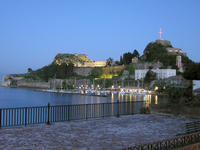You are in: Europe -> Greece -> Old Town of Corfu, and traditional search or Image Gallery will yield results of this site only
Old Town of Corfu
| Site number: | 978 |
|
| Type of site: | Cultural | |
| Date: | 8th century BC | |
| Date of Inscription: | 2007 | |
| Location: | Europe, Greece, Ionian Islands, Corfu Prefecture | |
Up to 75 images are shown here. Click on each for more details or on Image Gallery for more images.
| Description: | The Old Town of Corfu (8th Century B.C.) is located on the Island of Corfu in a strategic position at the entrance of the Adriatic Sea (lying off the western coasts of Albania and Greece). Renowned Venetian engineers designed the three forts of the town, which for four centuries defended the maritime trading activities of the Republic of Venice against the Ottoman Empire. The forts were repaired and partially rebuilt numerous times over the ages, most recently - under the British rule in the 19th century. The Old Town’s mainly neo-classical housing assortment remains partly from the Venetian period, partly of later construction, particularly the 19th century. Corfu's urban and port ensemble, as a fortified Mediterranean port, is noteworthy for its high level of integrity and authenticity. --WHMNet paraphrase from the description at WHC Site, where additional information is available. | |
| Corfu (Greek: Κέρκυρα - Kérkyra) is a city in north-western Greece. It is the capital and main town of the island and prefecture of Corfu. The city (pop. 28,185 in 2001) is a major tourist attraction, and has played an important role since the 8th century. The city has become known as a Kastropolis (Castle City) because of its three castles. In 2007, the old town of the city was inscribed on the UNESCO World Heritage List. The Municipality of Corfu (Kérkyra) generally stretches in a northwesterly direction from the city on the central east coast of the island, and has a land area of 41.905 km² and a total population of 39,487 inhabitants. Besides the city of Corfu/Kérkyra, its largest other towns are Kanáli (pop. 3,556), Potamós (2,365), Kontokáli (1,616), Alepoú (1,606), and Gouviá (952). --Wikipedia. Text is available under the Creative Commons Attribution-ShareAlike License. | ||
| Source: | http://whc.unesco.org/en/list/978 | |
| Reference: | 1. UNESCO World Heritage Center, Site Page. | |





























